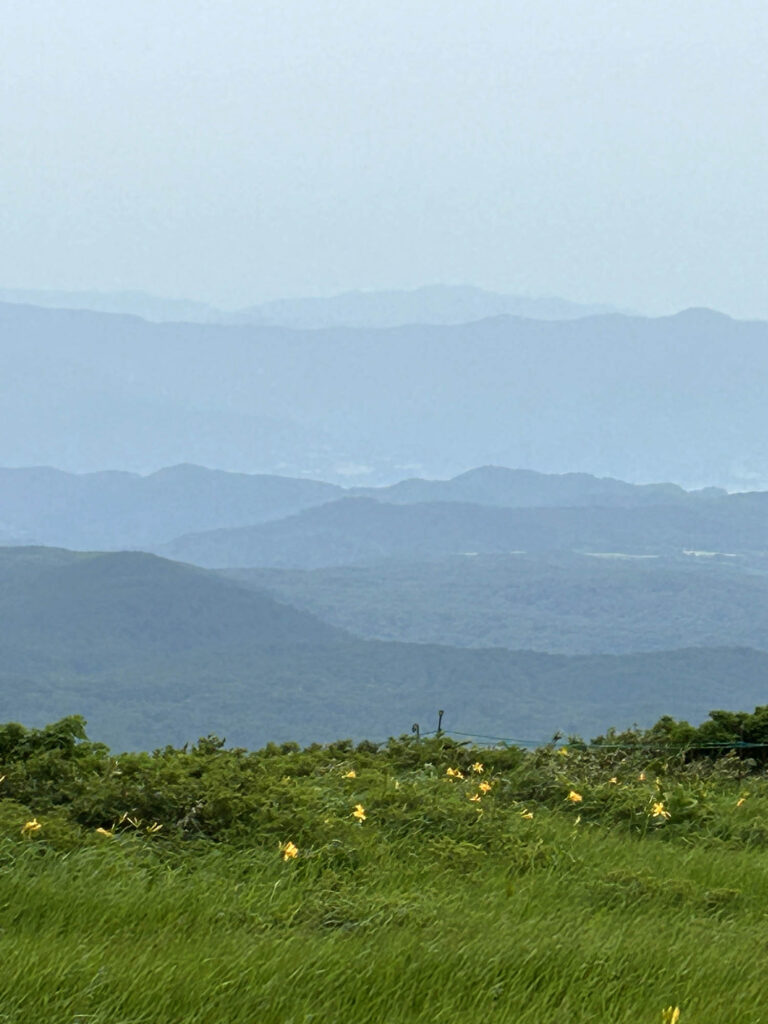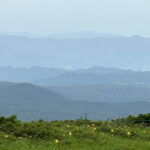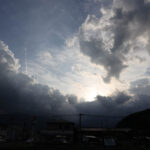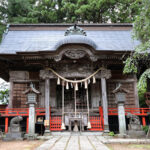夏草や兵どもが夢の跡
- 松尾芭蕉

Summer Grass. Photo Martin Edmond
natsukusa ya / tsuwamonodomo ga / yume no ato
The other night I woke from a disturbing dream. A nightmare, really. Some prince or warrior, some important samurai, was about to execute me. I didn’t know why; I only knew he had decided to spare my companion while inflicting a painful death upon me. I knew in the dream the method he was going to use but, upon waking, I forgot it. Just as well perhaps; I think it involved bricks and fire. However, I do remember the scene: a wide bare wooden floor, perhaps in a palace, the warrior king immersed in his affairs of state, and I bound, lying on a shirasu, a court of white sand, below the edge of the floor — until the moment came when he remembered he had a task to perform and turned his attention to me. I considered various forms of resistance but knew that they would all be futile. It was only when he was standing over me, about to inflict the fatal blow, that I managed to wake myself up. I was sweating and my heart was beating fast; but I was alive.
I’d probably drunk a bit too much sake the night before; I’d also been thinking, and reading, about these ancient warriors. When, for instance, the patron at Yakata said that Yoshitsune came through the pass below Aoso–san (‘Blue Hemp Mountain’) and must therefore have visited Togatta, I thought perhaps he was talking about the same person whose traces we had come across one day in Shinano: at a shrine beside the road to the recycling plant where, an information board said, his horse had left its hoofprint in a rock. And there it was, or something very like it. I went back to check the note I’d made at the time: no, I had confused Yoshitsune with Yoshinaka; it wasn’t Yoshitsune’s horse that left that mark, it was Yoshinaka’s. After his father had been killed by another member of his family, he had escaped to the then remote province of Shinano and lived there until summoned back to Kyoto to fight in the Genpei War.
And he and Yoshistune were contemporaries: both members of the Minamoto Clan who had fought in that war against the Taira Clan, celebrated in The Tale of the Heike. In fact they were cousins, and it was Yoshistune, under the instructions of his older brother Yoritomo, who brought about the death of Yoshinaka. He died in 1184 after the Battle of Awazu, along with his foster brother and loyal companion Imai Kanehira. Tomoe Gozen, the famous onna musha or woman warrior, daughter of Yoshinaka’s wet nurse and perhaps once his lover too, was also there but, on Yoshinaka’s orders, fled before she could be captured or killed. It is alleged that he did not want to die alongside a woman. Her fate is unknown: rumours of a forced marriage, a famous warrior son, a Buddhist nunnery, death at an undisclosed time and place.
It is also said that, after the battle was lost, with night coming on and many enemy soldiers in pursuit, Yoshinaka attempted to find an isolated spot in which to kill himself. However, his horse (the same horse which left the hoofprint in Shinano?) became bogged in the mud of a half frozen paddy field, and his enemies were able to approach and kill him; he died from an arrow to the heart; while Kanehira committed suicide by leaping from his horse with his sword in this mouth. Yoshinaka was buried at Otsu, in Omi, where a temple was built in his honour during the Muromachi Period (1336-1573); its name, Gichu-ji, uses the same kanji as Yoshinaka’s given name, Kiso. Matsuo Basho, the poet, who idolised Yoshinaka, asked that he too might be buried Otsu and his grave is indeed alongside that of his hero. Kanehira’s grave is there too, but some distance away.
Yoshinaka, then, was a casualty of internecine war amongst the Minamoto over who would rule once the Taira were defeated. And so, it turned out, was his nemesis, Yoshitsune. The year after Yoshinaka’s death, in 1185, Yoshitsune had to flee Kyoto in order to escape the wrath of his brother Yoritomo, the same man who had ordered him to kill Yoshinaka. Yoshitsune made his way north, in the company of his lover Shizuka Gozen, who was carrying their unborn child; but she somehow fell behind and was captured by forces loyal to Yoritomo. Yoshitsune, with his faithful retainer, the giant monk Benkei, continued north, arriving eventually at Hiraizumi, where he stayed for some years under the protection of Fujiwara no Hidehira.
He had lived there previously, as an adolescent, under the protection of the same man. But after Hidehira’s death his son, Fujiwara no Yasuhira, under pressure from Yoritomo, broke the promise he had made to his father and betrayed Yoshistune’s whereabouts. His castle at Koromogawa was surrounded, his retainers, including Benkei, killed, and Yoshitsune forced to commit seppuku. Yasuhira had Yoshitsune’s body decapitated, his head preserved in sweet sake, placed in a black-lacquered chest, and sent to Yoritomo as proof of his death. His treachery did not mean he prospered; Yoritomo soon got rid of him as well.
Sources differ as to the fate of Shizuka and their son. Some say that, like Tomoe Gozen, she became a Buddhist nun; others that Yoritomo killed both her and her son; or that she committed suicide by throwing herself in a river. There are alternative tales of Yoshitsune’s fate as well. Ainu say he escaped the siege at Koromogawa and fled north to Hokkaido, where he lived under the assumed name Okikurumi. In another version he sailed to the mainland and re-surfaced as the historical figure Genghis Khan (1162-1227). Yoshitsune was probably born in 1159 so the dates are plausible, even if little else about the story is; it seems to have been a Meiji Era invention by the writer Suematsu Kencho, who wished to amplify the prestige of his country’s history. Yoshitsune is enshrined at Shirahata Jinjo, a Shinto place in the city of Fujisawa in Kanagawa.
If Yoshitsune and Benkei had come through Togatta, when might that have done so and where might they have been going? It must have been after 1185, when Yoshitsune fled Kyoto and, pursued by Yoritomo’s men, went north to Hiraizumi. I looked at the map. If he had gone up the west coast of Honshu, along the Sea of Japan, he would at some point have had to cross the central spine of mountains towards the east: Hiraizumi is north of Sendai on the eastern side of the ranges. The main route these days goes from Niigata to Koriyama then north via Fukushima to Sendai and beyond; but there is another road, more obscure now and perhaps in those far off days as well. This follows the Arakawa River from Murakami through Sekikawa and Oguno to Nanyo, south of present day Yamagata. From there, Yoshitsume and Benkei could have travelled further east, through the mountain pass below Aoso-san, to Zao; and from Zao past where Sendai now stands and so on to Hiraizumi.
Just because this is possible, doesn’t mean it happened. And what about the other speculation that came up that night at Yakata, when the man in the blue shirt said Benkei fathered many children in the local area? That suggests a more prolonged stay. After all, he and Yoshitsume were fugitives for four years; and no-one seems to know exactly when they arrived at Hiraizumi, only when they died there. Saito Musashibo Benkei is a semi-legendary figure, six foot six inches tall, a warrior monk who had been a mountain ascetic, a yamabushi, before joining forces with Yoshitsune. The two are said to have met in Kyoto where Benkei, who thought the samurai of the capital decadent, had set himself to win, in combat, one thousand swords. He had collected nine hundred and ninety nine when he came across, one night, a slight young man with a gilded sword playing a flute at the Gojotenjin Shrine.
He challenged him to a duel, whereupon the two of them walked to the Gojo Bridge, where Benkei lost the fight to his smaller, more delicate, but much nimbler, antagonist — who was, of course, Minamoto no Yoshitsune. Seeking revenge, he also lost a return bout at the temple of Kioymizu, after which he became Yoshitsune’s loyal retainer. During the siege at Koromogawa, Benkei defended the bridge to the castle against all comers; he is said to have killed three hundred men. The attackers retreated and fired arrows at him and still he did not fall. When at last they had the courage to investigate, he turned out to have succumbed to multiple arrow wounds — but was nevertheless still upright. His ‘standing death’ has since become famous.
Hiraizumi was capital and principal city of the northern province of Mutsu, renowned for its gold and horses; both were valuable resources for the southern aristocracies and it seems that Yoritomo decided that the regime of the northern Fujiwara was a potential or actual rival to his own rule and had to be, not just subdued, but destroyed. The betrayal by Yasuhira, the deaths of Yoshitsune and Benkei, and the subsequent destruction of the city in 1189, during which Yasuhira died, were crucial events in his consolidation of the Kamakura bakufu (1185-1333), the military government Yoritomo founded.
Five hundred years had passed when Basho and Sora went to Hiraizumi and found nothing remaining of the dreams of warriors but summer grass. Another three hundred and thirty four years have gone by since then; but the names of Yoshitsune and Benkei are still on the lips of locals in Togatta. As are those of Basho and Sora on mine and many others also. Furthermore someone, perhaps the ghost of Yoritomo, was trying to do away with me too, just the other night.
- Martin Edmond








Great story. I’m glad you survived your dream 🙂
Martin says: Easier to survive the sake.